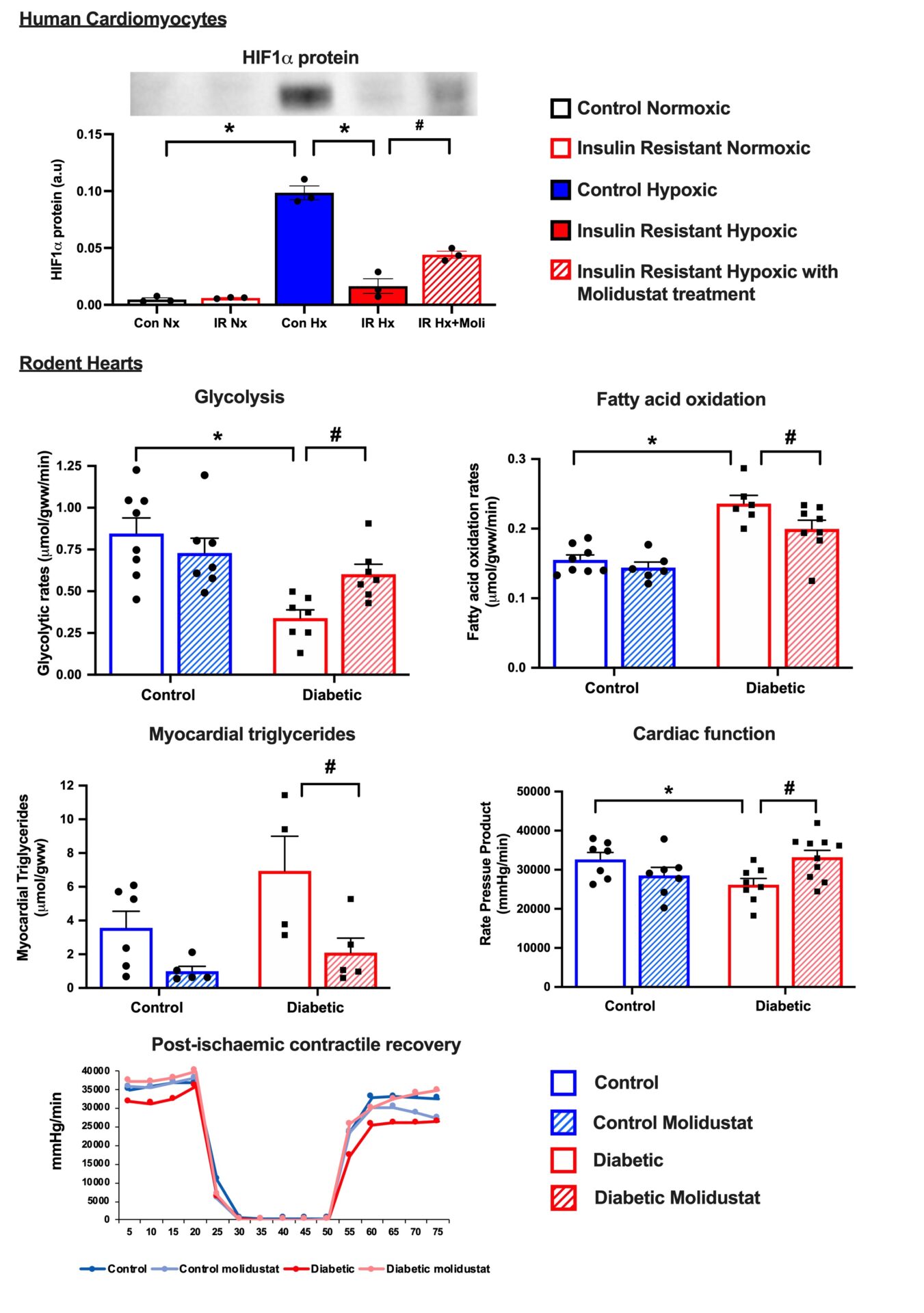Introduction and Aims: Cardiovascular disease is the leading cause of mortality in people with type 2 diabetes (T2D), with more rapid progression into heart failure post-myocardial infarction (MI). Hypoxia-inducible factor (HIF) is a master transcription factor regulating over 1000 genes critical for adapting the heart to survive when oxygen is restricted (hypoxia), as occurs following an MI [1]. We questioned whether diabetes impaired HIF signalling, contributing to decreased recovery post-MI, and whether pharmacologically targeting HIF was a novel treatment strategy for the diabetic heart. Methods: T2D was induced in the rat using high-fat diet (6 weeks) in combination with a single low-dose of streptozotocin (25mg/kg) (n=6) [2]. Human induced pluripotent stem cells were differentiated and matured into contracting cardiomyocytes (n=4), according to our published protocol [3]. Insulin resistance was induced in the human and rodent (HL1) cardiomyocytes by culturing in high palmitate (0.3mM), high glucose (12mM) and high insulin (50nM). Results: Insulin resistant human and rodent cardiomyocytes, when challenged with hypoxia (2% oxygen for 16 hr), had blunted activation of HIF1α protein, and decreased transcription of downstream HIF targets, including genes involved in anaerobic glycolysis, angiogenesis and autophagy. T2D hearts had decreased HIF1α activation within the myocardium in response to ischaemia. Blunted HIF1α activation suppressed the reprogramming of metabolism in hypoxia, maintaining a more mitochondrial oxidative metabolism rather than shifting towards anaerobic oxygen-efficient glucose metabolism. When challenged with whole body hypoxia (11% oxygen for 3 weeks in a hypoxia chamber), impaired HIF signalling in T2D rats resulted in blunted cardiac hypoxic adaptation and decreased cardiac function. Mechanistically, decreased HIF1α in T2D was due to the increased fatty acid (FA) concentrations within the circulation (hyperlipidaemia), and not related to the hyperglycaemia or hyperinsulinemia. Long chain FA, palmitate and oleate, were able to suppress HIF1α activation in response to hypoxia in a concentration-dependent manner, and could be reversed by blocking fatty acid entry into the cardiomyocyte. FA effect on HIF1α was mediated indirectly via changes in Krebs cycle intermediates. We demonstrate that increased succinate is required for optimal cardiac HIF1α activation in hypoxia, and that FA indirectly suppress succinate concentrations, causing suppressed HIF1α in T2D. Finally, HIF1α activators are undergoing phase III clinical trials for the treatment of renal anaemia associated with chronic kidney disease. We postulated that Molidustat, a HIF1α activator developed by Bayer, could be repurposed for the T2D heart, to restore HIF1α signalling and function post-MI. Molidustat (50μM for 16hr) activated HIF1α and downstream HIF signalling in insulin resistant human cardiomyocytes, overcoming the inhibitory effect of FA (Figure). In T2D rats, Molidustat (5mg/kg for 5 days) reprogrammed cardiac metabolism, increasing glucose metabolism and decreasing fatty acid oxidation and lipotoxicity. This culminated in increased cardiac function and increased recovery post-MI in Molidustat-treated T2D rats. Conclusions: Elevated FA in T2D suppress cardiac HIF1α activation in response to ischaemia, which culminates in blunted beneficial adaptation to hypoxia. Pharmacological activation of HIF1α with Molidustat provides a route to improve cardiac metabolism and function in T2D, and can be rapidly repurposed for clinical translatability.
Physiology 2021 (2021) Proc Physiol Soc 48, OC16
Oral Communications: Rescue of diabetes-induced HIF1α suppression recovers cardiac function and metabolism in the type 2 diabetes
Ujang Purnama1, Maria da Luz Sousa Fialho1, Michael Dodd2, Kaitlyn Dennis1, Claudia Montes Aparicio1, Damian Tyler1, Carolyn Carr1, Lisa Heather1
1 Department of Physiology, Anatomy and Genetics, University of Oxford, Oxford, United Kingdom 2 University of Coventry, Coventry, United Kingdom
View other abstracts by:
Where applicable, experiments conform with Society ethical requirements.

